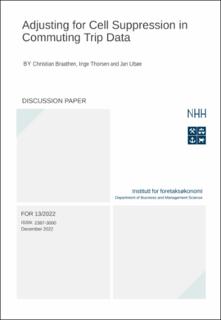Adjusting for Cell Suppression in Commuting Trip Data
| dc.contributor.author | Braathen, Christian | |
| dc.contributor.author | Thorsen, Inge | |
| dc.contributor.author | Ubøe, Jan | |
| dc.date.accessioned | 2022-12-13T14:03:22Z | |
| dc.date.available | 2022-12-13T14:03:22Z | |
| dc.date.issued | 2022-12-13 | |
| dc.identifier.issn | 2387-3000 | |
| dc.identifier.uri | https://hdl.handle.net/11250/3037535 | |
| dc.description.abstract | Maximum entropy methods are used to infer the true trip-distribution matrix in cases where parts of the data are suppressed due to privacy concerns. Large proportions of the suppressed data are found to be inferred correctly when the marginal totals in the trip distribution are known. Entropy-based approaches are further found to outperform a strategy of ignoring suppressed information in cases with suppressed marginal totals and/or a higher cut-off value of suppressing cell information. Our methods are demonstrated to reduce the systematic bias in estimates of the distance deterrence parameter to such small numbers that it is effectively zero, preventing potentially serious bias in estimates and predictions resulting from standard spatial interaction models. Another useful contribution is to identify what scenarios an entropy-maximization approach benefits from incorporating information on times series and/or information on distances in the transportation network. | en_US |
| dc.language.iso | eng | en_US |
| dc.publisher | FOR | en_US |
| dc.relation.ispartofseries | Discussion paper;13/22 | |
| dc.subject | Maximum entropy methods | en_US |
| dc.subject | trip-distribution matrix | en_US |
| dc.subject | spatial interaction | en_US |
| dc.title | Adjusting for Cell Suppression in Commuting Trip Data | en_US |
| dc.type | Working paper | en_US |
| dc.source.pagenumber | 46 | en_US |
Tilhørende fil(er)
Denne innførselen finnes i følgende samling(er)
-
Discussion papers (FOR) [566]
